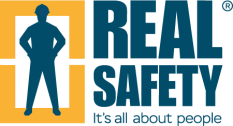Real Safety Contact Info:
Slips, trips and falls
Slips, trips, and falls (STF) are the primary source of injuries at work.
The number of these accidents is still high – despite measures set out by legislative requirements, best practices guidelines, and organisational policies to prevent STF accidents across industries like: maritime, offshore installations, construction sites, water treatment plants etc.
One of the most critical factors having an impact on STF is the slipperiness of the handrails, guardrails, walkways, decks, stairs, and surface of ladders.¹
Anti-slip management options
Research has shown that by implementing an Risk Management Option such as Real Safety’s KAG safety rails, anti-slip walkways or anti-slip solutions on stairs and ladders, the probability of STFs in a potential slip event is reduced from 10 % to 0.1 %. Indeed, a Danish offshore wind company reduced the number of STF accidents from 12 accidents with negligible consequences to 0 accidents after installing our anti-slip solutions. In another case, a Danish-flagged ship reduced the number of STF accidents from 3 to 0. ¹
¹ Master Thesis: Reducing Slips, Trips, and Falls in the Maritime Industry and Offshore Installations – Best Practice. Author: Tanja Rasmussen, Master of Risk and Safety Management, Aalborg University. 2021.
Lorem ipsum dolor sit amet consectetur
Lorem ipsum dolor sit amet consectetur
Lorem ipsum dolor sit amet consectetur
Lorem ipsum dolor sit amet consectetur
Lorem ipsum dolor sit amet consectetur
ACTIVE CAMPAIGN SLIP TRIP inserted here [activecampaign form=30 css=1]
Frequently Asked Questions
Lorem ipsum dolor sit amet, consectetur adipiscing elit, sed do eiusmod tempor incididunt ut labore et dolore magna aliqua. Ut enim ad minim veniam, quis nostrud exercitation ullamco laboris nisi ut aliquip ex ea commodo consequat. Duis aute irure dolor in reprehenderit in voluptate velit esse cillum dolore eu fugiat nulla pariatur. Excepteur sint occaecat cupidatat non proident, sunt in culpa qui officia deserunt mollit anim id est laborum.
Duis aute irure dolor in reprehenderit in voluptate velit esse cillum dolore eu fugiat nulla pariatur. Excepteur sint occaecat cupidatat non proident, sunt in culpa qui officia deserunt mollit anim id est laborum.
Lorem ipsum dolor sit amet, consectetur adipiscing elit, sed do eiusmod tempor incididunt ut labore et dolore magna aliqua. Ut enim ad minim veniam, quis nostrud exercitation ullamco laboris nisi ut aliquip ex ea commodo consequat. Duis aute irure dolor in reprehenderit in voluptate velit esse cillum dolore eu fugiat nulla pariatur. Excepteur sint occaecat cupidatat non proident, sunt in culpa qui officia deserunt mollit anim id est laborum.
Duis aute irure dolor in reprehenderit in voluptate velit esse cillum dolore eu fugiat nulla pariatur. Excepteur sint occaecat cupidatat non proident, sunt in culpa qui officia deserunt mollit anim id est laborum.
Lorem ipsum dolor sit amet, consectetur adipiscing elit, sed do eiusmod tempor incididunt ut labore et dolore magna aliqua. Ut enim ad minim veniam, quis nostrud exercitation ullamco laboris nisi ut aliquip ex ea commodo consequat. Duis aute irure dolor in reprehenderit in voluptate velit esse cillum dolore eu fugiat nulla pariatur. Excepteur sint occaecat cupidatat non proident, sunt in culpa qui officia deserunt mollit anim id est laborum.
Duis aute irure dolor in reprehenderit in voluptate velit esse cillum dolore eu fugiat nulla pariatur. Excepteur sint occaecat cupidatat non proident, sunt in culpa qui officia deserunt mollit anim id est laborum.
Lorem ipsum dolor sit amet, consectetur adipiscing elit, sed do eiusmod tempor incididunt ut labore et dolore magna aliqua. Ut enim ad minim veniam, quis nostrud exercitation ullamco laboris nisi ut aliquip ex ea commodo consequat. Duis aute irure dolor in reprehenderit in voluptate velit esse cillum dolore eu fugiat nulla pariatur. Excepteur sint occaecat cupidatat non proident, sunt in culpa qui officia deserunt mollit anim id est laborum.
Duis aute irure dolor in reprehenderit in voluptate velit esse cillum dolore eu fugiat nulla pariatur. Excepteur sint occaecat cupidatat non proident, sunt in culpa qui officia deserunt mollit anim id est laborum.



